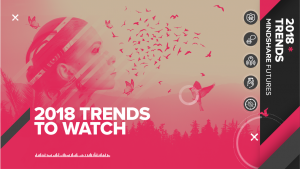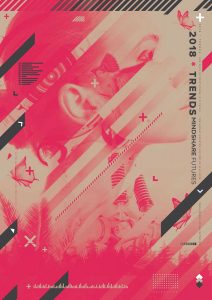 Mindshare UK has launched its Trends Report 2018 which identifies the top five trends for marketers to watch in 2018.
Mindshare UK has launched its Trends Report 2018 which identifies the top five trends for marketers to watch in 2018.
The report investigates a variety of topics from AR to AI and shows how consumers across all ages are embracing technological advancements with 46% of consumers willing to use facial recognition as a form of official I.D, and 57% agreeing that machines will be able to do tasks more effectively than humans. In fact, 43% agree that it’s sometimes easier to deal with a machine than a real person so much so 1 in 3 millennials surveyed would prefer an artificially intelligent politician.
Created by the Mindshare Futures team, the trends were compiled through surveys with over 6,000 consumers aged 18+ across the UK, in addition to qualitative research and social and search analysis. They are part of Mindshare’s unique consumer centric research approach to Futures that places people firmly at the heart of their findings.
“The media industry is very good at talking about trends and how technology reshapes the ways brands can reach consumers, but all too often the human at the receiving end is neglected. Our Trends offer something different– they are built upon a unique and extensive consumer research programme which places people firmly at the heart of each trend. Given the polarisation of opinions we’re seeing within the UK, this year we’ve placed greater emphasis on exploring how our trends differ in terms of adoption and relevancy across the whole country and many different walks of life, said Helen McRae,” CEO, Mindshare.
“We’ve investigated everything from AI and data to AR and visual recognition, and by and large we can see that whatever else they might disagree on, people are open to embracing many of these new technological advancements, especially if it enhances their lives in some way. With 43% of consumers preferring to deal with a machine rather than a real person, brands have a real opportunity to capitalise on this trend if they are willing to adapt their strategies to instil confidence whilst still allowing humans to retain control.”
Mindshare – The 5 Trends for Brands to Consider in 2018:
 Trend 1 – Automatic for the People
Trend 1 – Automatic for the People
With 100,000 chatbots on Facebook messenger, in-store virtual assistants guiding shopping experiences, walk-in stores that are staff-free and run entirely by technology, human interaction is on the decline. As automation becomes more widespread in everyday life, people will be thinking more consciously about its promise of greater convenience versus the loss of human interaction.
- 54% would go for the quickest and most convenient option when faced with the choice between human and automated service
- 57% can imagine a time in the next few years when machines can do tasks more effectively than we can
- 43% agree it’s sometimes easier to deal with a machine than a real person (rising to over half (52%) of 18-34s)
- 60% would prefer car comparison advice from AI versus a person, but only 11% would prefer medical advice from AI
- 1 in 3 millennials would prefer an artificially intelligent politician over a human politician
For any brand using automated options this will mean designing services that fulfil this need for convenience whilst still allowing humans to retain control. Focusing on offering automated services in very specific roles on the consumer journey will also instil confidence, rather than trying to fulfil too many functions at once.
Trend 2 – Destination Data
Our data footprint is increasing both in magnitude and in range and most of us are all too aware that we are giving away increasingly more of our personal data. An uneasy sense of inevitability exists around the data exchange. As data becomes a hotter topic in 2018, people will be radically re-appraising their attitudes and behaviour towards it.
- 80% would like more control over what brands do with their data however 58% agree to terms and conditions without properly reading them, rising to 70% of 18-24s
- 65% admit they know their data has value to companies yet don’t know how to use it to their advantage
- 53% of people would be willing to give away their data for a financial incentive or cash reward
- A quarter of 18-24s tape or cover their webcam/phone camera
- 38% of people would choose to give Amazon access to their data over Facebook, Google and Apple (rising to 48% of 65+)
Consents will be key in 2018, so work out what that acceptable data exchange with consumers is way in advance of GDPR. It is imperative that brands maintain transparency with consumers and offer them tangible benefits for supplying their data to help instil trust.
Trend 3 – Access All Areas
Our mobiles have made us more and more accustomed to accessing almost anything we want, whenever and wherever we want it. This level of access and connectivity is set to become even more pervasive, as we go beyond the mobile device. We will come to expect smooth and seamless access to everything, with new devices that link up more effectively, fuelled by a supercharged infrastructure.
- 53% welcome the idea of connecting to the internet in lots of new ways (rising to 67% for 18-24s)
- 58% can’t imagine a time where we aren’t reliant on screens
- 46% would pay a single fee (like a license fee) to ensure they’re always connected, rising to 61% of 18-24s
- 73% want to be connected whilst travelling or on the move
- 69% would like to completely disconnect at mealtimes (rising to 73% among women)
- There are still over a quarter of people (27%) that wish for better connectivity at home
Brands will need to achieve consistency of brand experience across all these different platforms as well as flexibility between channels. Content will need to be tailored to the context with much greater subtlety, as people flit between devices in both communal and one-to-one situations.
 Trend 4 – Exploration Game
Trend 4 – Exploration Game
Increasingly life is presenting us with too many options to deal with, too many things to choose from, and at times this has started to feel overwhelming. Technology, however, is helping with some of this overload and making it easier than ever to explore. Whether it’s algorithms recommending new music, virtual assistants suggesting new recipes, smart mirrors helping us visualise an outfit or AR apps that help us try before we buy. Technology is helping us to answer questions such as What’s new? What else might I like? What would it be like to? What could this look like?
- 82% describe the recommendations they receive from algorithms as acceptable or better
- 71% click on content that has been recommended to them online
- 48% admit to using technology for inspiration more often these days, rising to 60% for 18-34s
- 70% would find it helpful to visualise goods/services before purchasing them
- 35% say that they have tried Augmented Reality experiences, rising to 76% for 18-24s
Brands who are planning to tap into these new exploration opportunities will need to identify how the needs of their customers vary throughout the entirety of the decision experience – using this knowledge to identify those ideal moments for inspiration and imagination. Mobile will be at the heart of many of these moments, so it would be useful to carry out an audit of the customer’s experience on this platform.
Trend 5: Get Snappy
Our culture has become increasingly visual. Combine this with the rapidly improving image recognition capabilities of AI, we are set to see further developments in areas such as visual search, code scanning and facial recognition. This means that we will increasingly turn to images for quicker and easier interactions – helping us to find, record, unlock, activate, identify, match, buy and much more.
- 45% take photos or screenshots to help them remember things
- 29% have used visual search (rising to 55% for 18-24s)
- 31% have scanned codes or pictures for access to information
- 46% would be comfortable using facial recognition as a form of official I.D but only 31% would be comfortable using facial recognition to pay for goods or services.
For brands, there will likely be processes or points in the purchase journey that could be simplified using image recognition, whether it’s providing easier access to product specs or providing quicker payment options. Products will also need to be made valuably interactive via the use of images. It will also be vital that brands understand how people might be visually searching for their products and optimise their content for image search.
Source: Mindshare UK

You must be logged in to post a comment Login